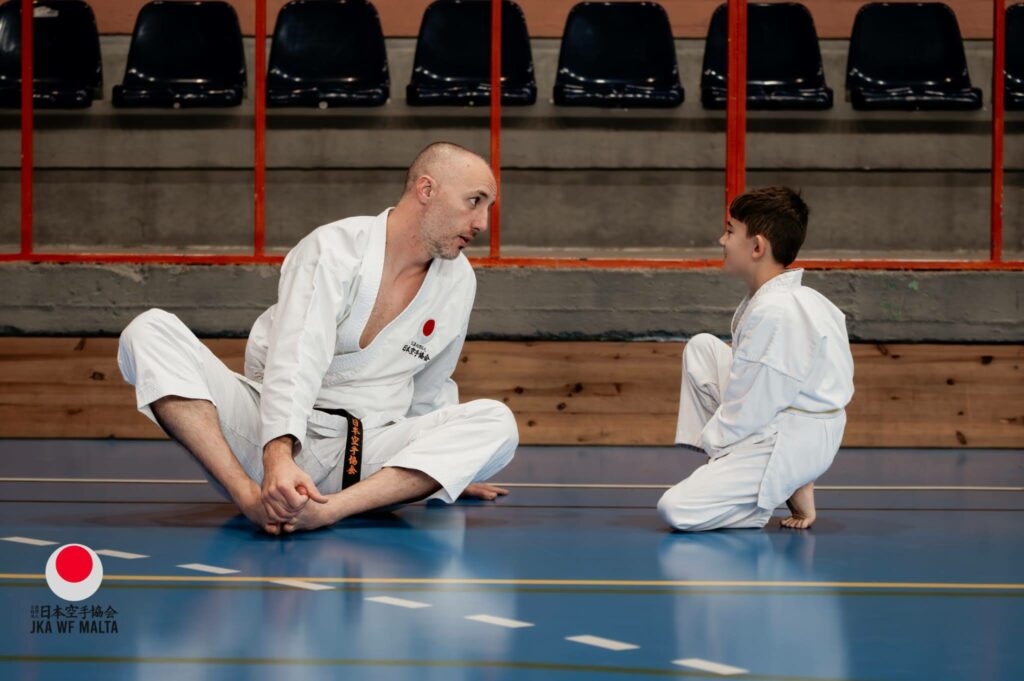DOJO ETIQUETTE
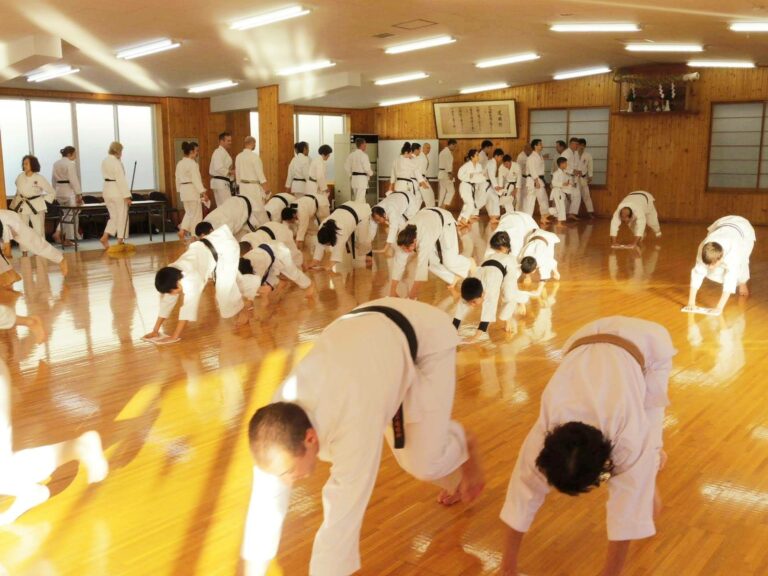
‘Soji’ at end of Training at JKA Headquarters, Tokyo
Dojo etiquette, or “Reigi” in Japanese, is a set of customs and protocols observed within the dojo in Japanese martial arts.
- Rei/ Bowing (礼) is a form of showing respect and expressing gratitude in Japanese culture. Practitioners typically bow upon entering and leaving the dojo, as well as when greeting the instructor (Sensei) and fellow practitioners. It is essential to bow with proper posture and sincerity.
- Addressing Others: In the dojo, practitioners often address each other and their instructors using appropriate titles, such as “Sensei” for the instructor and “Senpai” for senior practitioners. This demonstrates respect for their experience and knowledge.
- Uniform and Hygiene: Practitioners are expected to wear clean and properly fitting uniforms (dogi) during training. Maintaining personal hygiene, including trimmed nails and clean feet, is also important out of respect for oneself and others.
- Quiet and Focused Atmosphere: The dojo is a place for focused training, so practitioners are expected to maintain a quiet and respectful atmosphere. Talking should be kept to a minimum, and any conversations unrelated to training should be reserved for before or after class.
- Following Instructions: Practitioners should listen attentively to instructions and follow them promptly and respectfully. This includes following the class structure, performing techniques as demonstrated, and practicing with safety in mind.
- Helping Others: Senior practitioners (senpai) often assist junior members with their training. Helping others not only fosters camaraderie but also reinforces one’s own understanding of the art.
- Cleaning and Maintenance: At the end of training sessions, practitioners typically participate in cleaning the dojo and maintaining training equipment. This practice, known as “soji,” reinforces the value of cleanliness, respect for the training space, and shared responsibility.
- Maintaining Discipline: Practitioners are expected to conduct themselves with discipline and self-control at all times – by controlling one’s emotions, refraining from aggressive behavior, and showing respect for all individuals in the dojo.
Through Reigi, martial artists develop a mindset of mutual respect, discipline, and integrity, fostering a positive, harmonious and respectful training atmosphere both within and beyond the dojo.
SEIZA
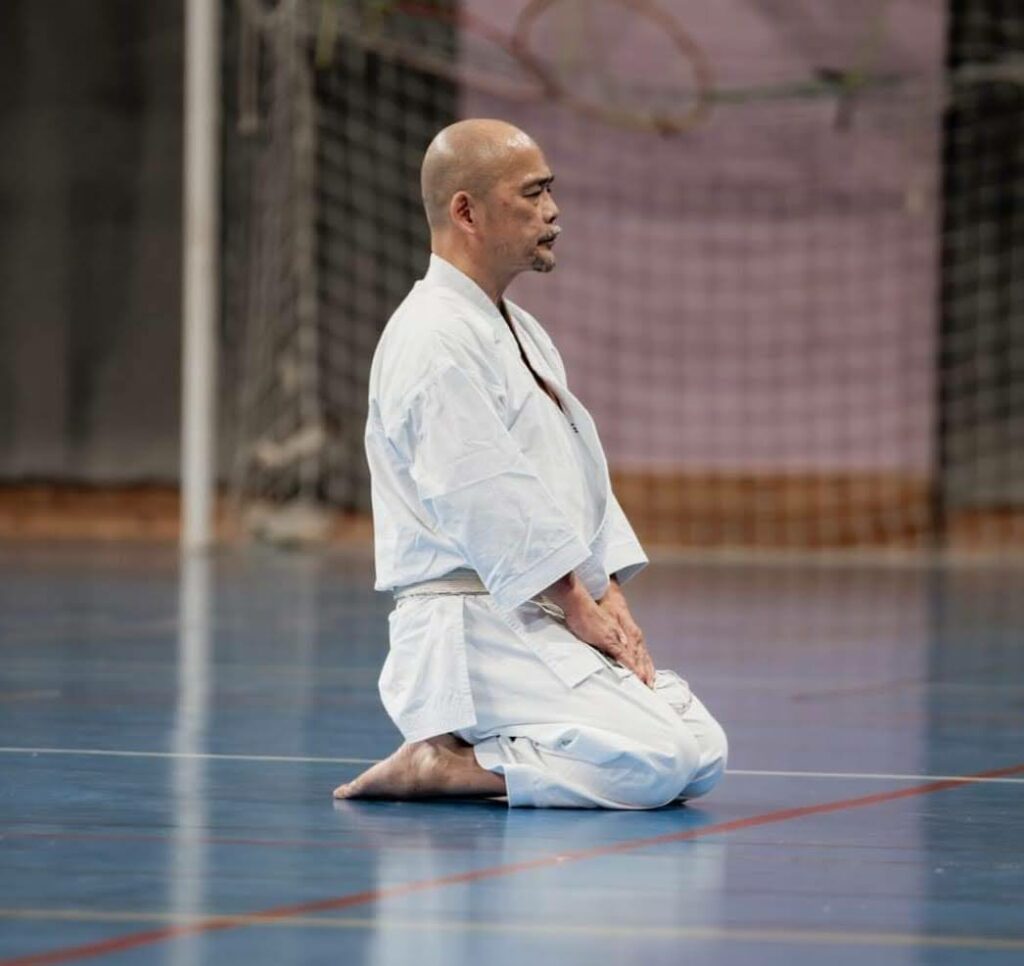
“Seiza” (正座) means the “correct sitting posture” and is a fundamental aspect of Japanese culture.
This posture involves kneeling on the floor, with the tops of the feet flat against the ground and the buttocks resting on the heels, while maintaining a straight back and an upright head.
In Karate, Seiza is performed at the beginning and end of training sessions or when entering and leaving the dojo as a sign of respect towards instructors and senior practitioners, students and also to the place of training, the dojo itself.
Moreover, practicing Seiza offers physical benefits by enhancing flexibility, strength, and stability in the knees, ankles, and hips, while promoting proper posture and alignment essential for balance and stability during training sessions.
By embracing Seiza, martial artists not only honor the traditions and values of their art but also foster an environment of respect, humility, mindfulness and discipline within the dojo; principles that are deeply ingrained in Japanese society.
More about this on: https://www.facebook.com/share/v/mg31TGZJCpVubn6F/
MOKUSOU
In Karate dojos, the practice of “Mokusou” before and after training holds a significant place in traditional Karate training. Mokusou means to stay silent and think about the training with images; Using photographical images that we remember seeing with our eyes and felt with our heart/emotion.
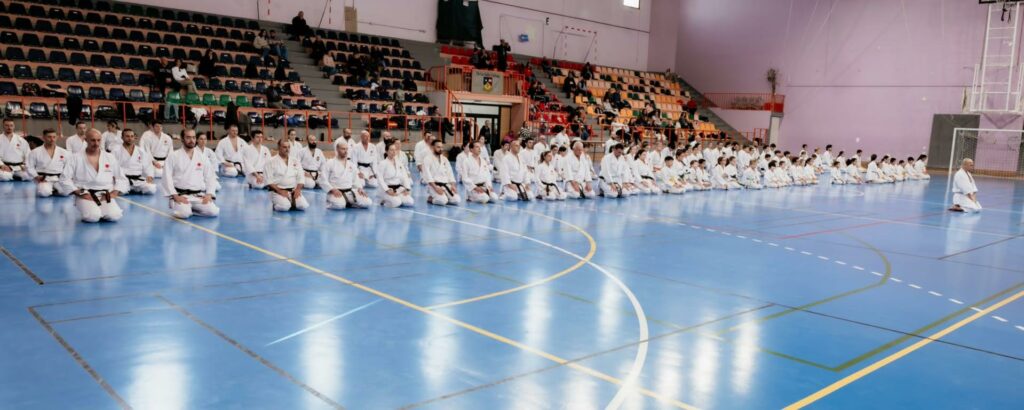
Before training, one should imagine the things that must be done better or tried in a different way, mentally rehearsing specific moves, imagining executing them flawlessly, or picturing scenarios where adjustments can be made for better performance during the training session.
In Mokusou after training, one would image and mentally replay what happened during the training, perhaps of how Sensei showed certain techniques/exercises that must be replicated better next time or maybe envisioning onself executing techniques or exercises with greater precision.
So mokusou must not be confused with meditation or with Mushin.
MUSHIN - THE EMPTY MIND
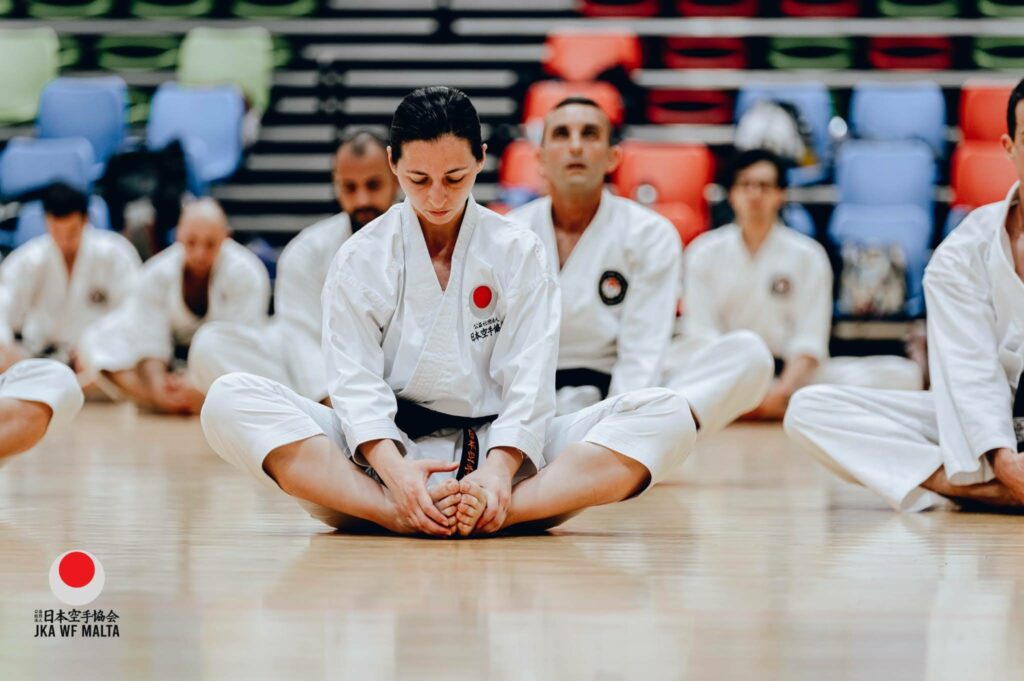
Mushin, translated as ‘Empty your mind’, encapsulates the essence of Zen philosophy. One tries to clear their mind of distractions, allowing for complete concentration in the present moment. Just like when an artist is completely absorbed in painting a picture. It is about finding serenity and calm in this focused state.
As Bruce Lee famously expressed, “Empty your mind, be formless, shapeless like water.” In this state, the mind is free to focus on what truly matters, which is crucial for a fulfilling life.
Achieving Mushin is a very difficult challenge. Yet, when attained, it brings clarity and calm, and creates a heightened awareness of one’s surroundings and inner self even in every day life.
In JKA karate, empty mind is emphasized as part of the mental discipline required for effective technique execution, self-control, and mastery of the art, letting go of unnecessary thoughts and emotions that may hinder performance, to achieve a clear state of calmness.
ZANSHIN
Zanshin, deeply rooted in Japanese culture, embodies the concept of remaining conscious, attentive, and aware. In sports jubilant celebration usually follows victory. However, nobody does that in true martial arts. Practitioners maintain a state of heightened awareness and readiness, without relaxing their consciousness, keeping in mind that another attack may follow. This mindset emphasizes the importance of staying focused, teaching practitioners not to show their inner feelings and to be prepared for any potential threats; a principle applied across all forms of Budo.
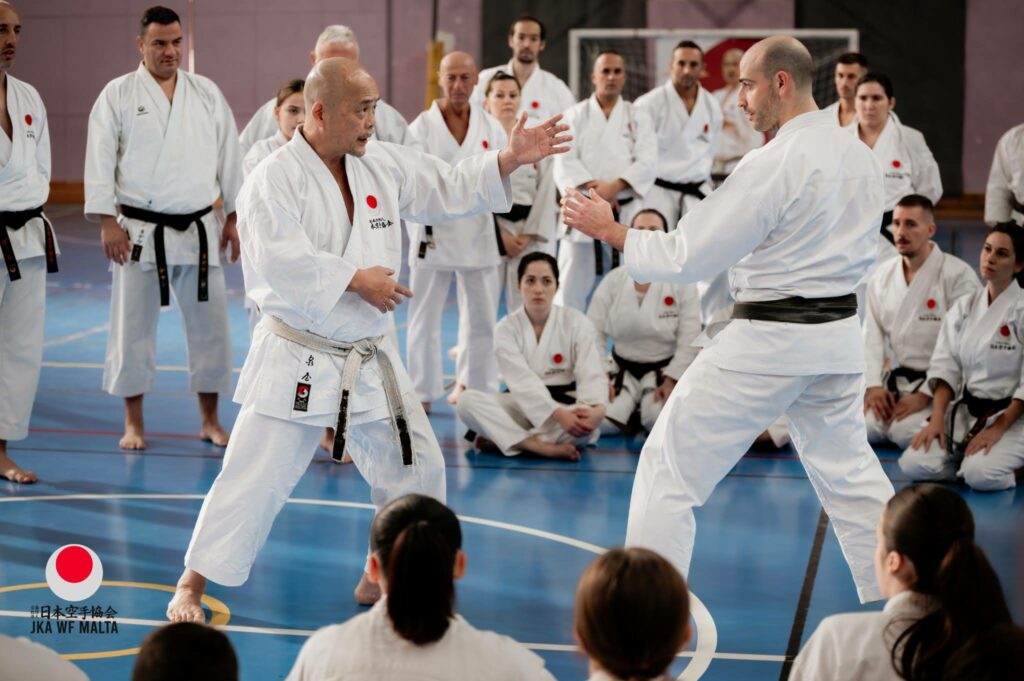
OSU
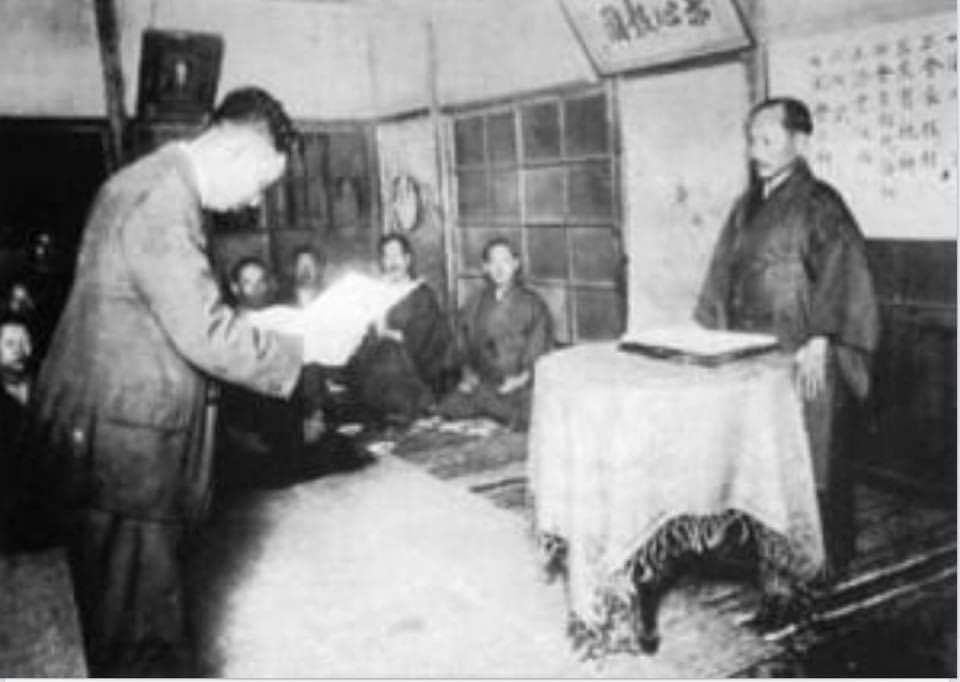
photo [April 12th 1924, first ever Shodan certificate awarded by Funakoshi Sensei] https://www.facebook.com/profile.php?id=100064650104224
‘Osu’ or ‘Oss’ 押忍 has become widely utilized in martial arts culture for various purposes such as greeting, saying ‘excuse me’, expressing gratitude, confirming readiness and acknowledging instructions from seniors.
The origins of “osu” or “oss” are intriguing because they’re not commonly used by Japanese people and are typically frowned upon if used in general conversation, due to its slang nature. However, in the world of karate, “oss” takes on an entirely different meaning.
In the early Showa period, “OSU” was the shortened version of goodmorning “OHAYOU GOZAIMASU” → “OHAYO SSU” → “OSSU” → “OSU” or “OSS,” and young men began to use it for colloquial greetings.
However, the true essence of ‘Osu’ in Karate stems from the concept of “OSHI SHINOBI,” signifying perseverance under extreme pressure.
During the Edo period in Japan (1603-1868), martial arts, particularly various styles of bujutsu (martial arts focused on combat techniques), were widely practiced among the samurai class. Within this context, the concepts of discipline, respect, and perseverance were deeply ingrained in martial arts training.
The kanji characters “押” and “忍,” which make up the term “Osu,” were associated with martial arts practice during this period. While the pronunciation “Osu” might not have been prevalent at the time, the meanings represented by these characters were significant in martial arts philosophy.
– “押” (pronounced as “osu” or “osa”) can mean “to push” or “to press.” In martial arts, it symbolizes the idea of pushing oneself beyond physical and mental limits, persevering through challenges, and exerting maximum effort in training.
– “忍” (pronounced as “shinobu” or “nin”) refers to “endurance” or “patience.” It embodies the concept of perseverance, resilience, and the ability to endure hardships without giving up, which is fundamental in martial arts training.
If one analyses the actual Kanji characters they reveal a very intriguing interpretation related to the Samurai era: “I possess a Katana and therefore have the capability to defeat you, yet I exercise self-control and refrain from doing so because I Respect you.” As explained on: https://youtu.be/G8jyhTRj2Xw?si=uzx4wPDyfmRa-HOW
While the specific pronunciation of “Osu” may not have been documented during the Edo period, the underlying principles represented by the Kanji characters and meaning were likely incorporated into martial arts teachings and practices.
Over time, as martial arts evolved and modernized, the term “Osu” emerged as a colloquial expression among practitioners, encapsulating the spirit of discipline, respect, and perseverance that had its roots in the martial traditions of Japan’s feudal era.
Though some speculate its usage in the old NAVY, there’s no official military endorsement of “OSU,” indicating its informal nature. However, it gained prominence when Japanese karate practitioners adopted and spread “OSU” globally, facilitated by its easy pronunciation for both Japanese and non-Japanese speakers.
SENSEI, SENPAI, KOHAI
In Japanese martial arts and other traditional settings, the titles Sensei, Senpai, Kohai are used according to the relation of one’s self to others within the dojo or society. The word “Sensei” is used to address a teacher or mentor, showing respect for their knowledge and experience. “Senpai” refers to a senior or more experienced member, often someone who has been training longer or holds a higher rank than you. Care must be taken to speak politely when talking to Sensei and Senpai. “Kohai” refers to a junior or less experienced member, someone who is newer to the practice or holds a lower rank. It’s customary to address one’s sensei with their name followed by the word “Sensei”, while senpai and kohai are typically addressed without any specific honorific, using their name or title directly.
